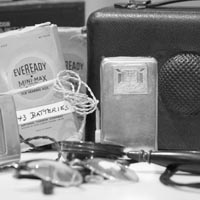A History of Hearing Aids
Hearing aids have come a long way. It wasn’t until the mid-late 1950’s the first Analog transistor hearing aids were available. There are different era’s per say, on the development of hearing aids over hundreds of years. The acoustic era covers the time period when humans first cupped their ear to increase amplification. Around 1650 was the first documented time ear horns were used. Originally these horns were large and bulky. A few modifications later they coiled it up and tried to conceal it as best as possible. Some people would even hide it in beards, or clothing!
 The larger table body aids were next, which emerged throughout the early 1900’s. Consisting of very large microphones, receivers and gigantic batteries. After several generations of these large essential components, the hearing aid was finally able to move up to the head. In 1954 the first head mounted hearing aids were available. They were built into fashion accessories such as barrettes or eyeglasses. Several were even made to resemble jewelry. In the mid-late 1950’s the first ear level hearing aid was available. Over the next 40+ years the battery, microphone, receiver, and transistor technology continued to develop, modernizing the hearing aid every step of the way.
The larger table body aids were next, which emerged throughout the early 1900’s. Consisting of very large microphones, receivers and gigantic batteries. After several generations of these large essential components, the hearing aid was finally able to move up to the head. In 1954 the first head mounted hearing aids were available. They were built into fashion accessories such as barrettes or eyeglasses. Several were even made to resemble jewelry. In the mid-late 1950’s the first ear level hearing aid was available. Over the next 40+ years the battery, microphone, receiver, and transistor technology continued to develop, modernizing the hearing aid every step of the way.
In 1996 fully digital hearing aids became available in several styles of hearing aids. Digital hearing aids offer precision in programming, intelligent automatic manipulation of gain and frequency responses in hearing aids. Additional features include feedback limiting and reduction in size and power requirements of the battery.
Between late 1980’s and late 1990’s hearing aid satisfaction and success rates did not improve. This is because we had neared the limits of what we could accomplish with analog technology. Finally, in 2000 surveys were performed showing improvement in usage, satisfaction and listening comfort due to improvements resulting from the digital technology. This increase in user satisfaction continues to this date, as new computer chips and improvements in process are progressing even more quickly.
Difference between Analog and Digital
The difference between Analog and Digital hearing aids is quite vast. Analog uses older, much simpler technology. Analog hearing aids work by amplifying all sounds. Soundwaves are made continuously louder. Hearing health care professionals use potentiometers to make small adjustments on the overall amplification for certain frequencies.
Benefits of Analog Hearing Aid included:
- They generally had a lower cost compared to digital hearing aids
- Worked well for listening to music
- Some long time hearing aid users preferred analog sound quality over initial digital options
Digital Hearing Aids on the other hand offer many technology improvements, user friendliness and beneficial computer chip advancements. As a result, it allows for adjustable program features such as background noise reduction, speech intelligibility, Bluetooth connection and direct streaming to name a few. They also allow both hearing aids to communicate together, working as a system rather than having them each doing their own thing. Most noteworthy, they differ from analog devices in that they convert sound waves to digital signals. This allows the device to produce an exact duplication of each sound, instead of providing amplification to all sounds.
Advantages of Digital Hearing Aids
- Offers noise reduction to help reduce background noise
- Offer increased comfort
- Huge improvement in reducing unwanted feedback and whistling
- Highly programmable for various listening environments
- Flexible and adjustable for specific user needs
Hearing aids are costly medical devices, however there hasn’t been drastic changes in the pricing in over a decade. Consequently, the reintroduction of reliable, rechargeable hearing technology in the past two years increased the pricing slightly. However, some would argue that convenience and never having to change a battery again is worth the price tag.
Is the Age of Analog Over?
Not quite yet. With all of the benefits that Digital technology has to offer, you are unlikely to find any traditional Analog products on the market any time soon. With that said, Phonak’s Lyric device is the World’s first and only extended wear hearing aid. Its unique design and style shows how analog technology can still be relevant.






